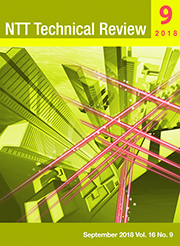
You need Adobe Reader 7.0 or later in order to read PDF files on this site.
If Adobe Reader is not installed on your computer, click the button below and go to the download site.

|
September 2018 Vol. 16 No. 9 |
|

Feature Articles: Research and Development Initiatives for Internet of Things Implementation-
 Research and Development to Create Value with IoT Research and Development to Create Value with IoT

Abstract
Utilization of Internet of Things (IoT) technology is advancing as part of efforts to create new value in various fields, even those with little previous relation to information and communication technology. In view of this IoT era that will drive industry and society forward, NTT has defined four necessary roles in terms of requirements and technologies, and we are collaborating with our partners to build key technologies. In this article, we introduce technical development initiatives at the NTT laboratories to further advance IoT.
-
 Application for Rehabilitation Medicine Using Wearable Textile °»hitoe°… Application for Rehabilitation Medicine Using Wearable Textile °»hitoe°…

Abstract
NTT, Toray Industries, Inc., Fujita Health University, and NTT DOCOMO have begun trials on patient rehabilitation support using the functional material called °»hitoe,°… which can take continuous measurements of biological data simply by having patients wear it. As innovation progresses in medical and nursing care, it is necessary to improve the quality of rehabilitation, especially for elderly patients, in the recovery progress and return to daily life, and in preventing the recurrence of debilitation. This article introduces new initiatives to develop wearable technology in light of these social issues.
-
 Wireless Relay Technologies for Monitoring Underground Infrastructures Wireless Relay Technologies for Monitoring Underground Infrastructures

Abstract
With the progress made in Internet of Things (IoT) technology, expectations have been raised for IoT services in areas outside the bounds of network coverage such as underground, underwater, and sky environments. We have been developing wireless communication systems aimed at achieving monitoring capabilities of aging underground infrastructures. Our systems make use of wireless relay terminals installed on vehicles or utility poles to efficiently collect data from sensors installed in underground infrastructures. In this article, we introduce two recently developed technologies for radio relay systems that are designed to reduce the costs of installation and operation of the system. One extends the coverage area, and the other reduces power consumption.
-
 Data Stream Assist Technology Supporting IoT Services Data Stream Assist Technology Supporting IoT Services

Abstract
NTT Network Technology Laboratories has been researching and developing data stream assist technology that can be deployed lightly and flexibly to provide a network that supports complex services using Internet of Things (IoT) devices with high functionality and performance. In this article, we introduce technologies that improve the utilization efficiency of the network and the convenience of IoT services by changing the communication protocol, communication timing, and traffic volume according to various multipurpose versions of 4K surveillance camera images.
-
 Utilization of Edge Computing and IoT Sensors in Hierarchical Weather Forecasting System Utilization of Edge Computing and IoT Sensors in Hierarchical Weather Forecasting System

Abstract
NTT and the Japan Agency for Marine-Earth Science and Technology (JAMSTEC) began collaborative research on a hierarchical weather simulation system using the Earth Simulator and edge computing in 2016. This project promotes the creation of new technology for the interworking of geographically distributed Internet of Things (IoT) sensors, regionally located edge computing, and the Earth Simulator that is capable of large-scale weather simulation. The project also promotes the development of fundamental technology for supporting various IoT services.
Regular Articles-
 New Transport QoE-control Technology Enabling High-definition/High-presence Content Distribution New Transport QoE-control Technology Enabling High-definition/High-presence Content Distribution

Abstract
NTT is striving to support the growing demand for high-definition video delivery services and is therefore developing technologies for optimizing the deployment of servers for content providers and telecom operators and their communication networks and for providing a new means of delivery control. This article introduces content delivery network technology for achieving economical and high-quality delivery of high-definition, high-presence video content.
Global Standardization Activities
Short Reports
External Awards/Papers Published in Technical Journals and Conference Proceedings
|
